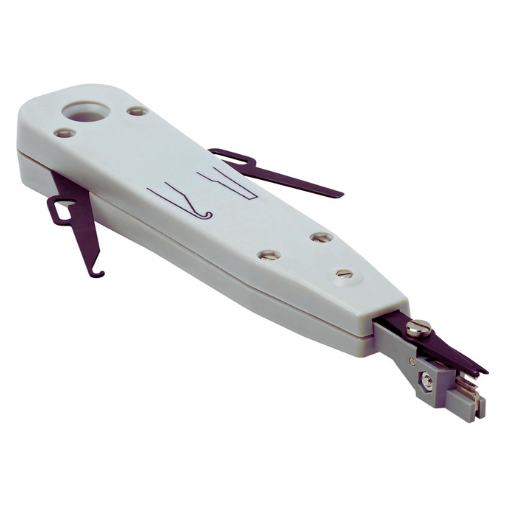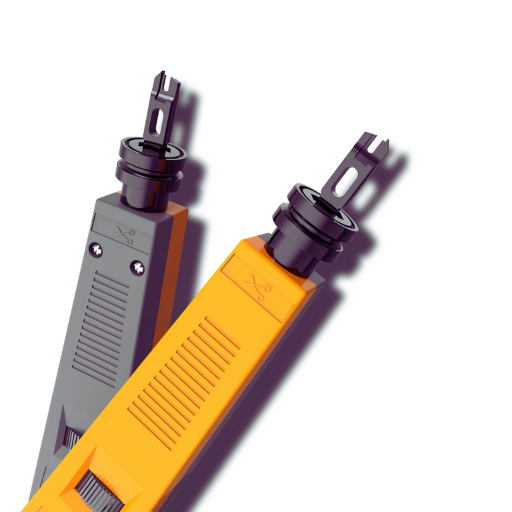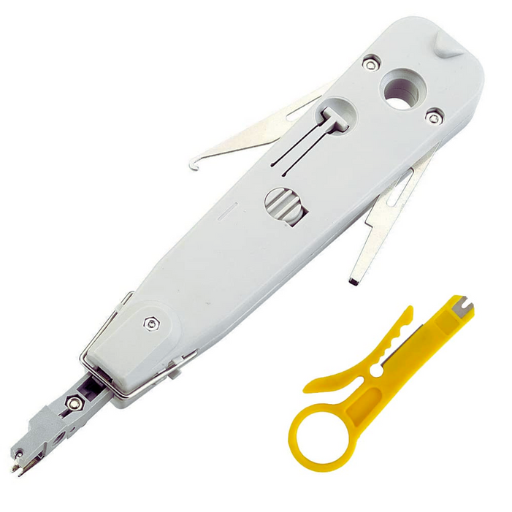The telecommunications and computer networking field would not be complete without a punch down tool. The main use of this tool is to put wires into insulation displacement connectors (IDCs). These connectors are commonly found on patch panels, surface mount boxes, and keystone modules. When the knife simultaneously severs the wire as it is being connected through this device, it ensures reliability by creating secure connections electrically isolated from each other. To avoid shorting or connectivity issues that may arise from overlapping wires with different functions; such as data transmission line touching power supply line or signal ground; among others. Apart from making cable installations easier because of its user-friendly design, it also reduces fatigue in hands caused by repetitive actions hence becoming an essential equipment for any network installer who wants to work faster while remaining accurate always. Knowing how this gadget works and where best can it be applied guarantees success in performance thus maintaining integrity within the network system.

A punch down tool is a specialized device that is used in telecommunications and data networking to insert and terminate wires into insulation-displacement connectors (IDC). The main purpose of this device is to connect wire ends securely and correctly in patch panels, keystone modules, and surface-mount boxes. Moreover, it also cuts the wire simultaneously at appropriate length thus preventing accidental short circuits as well as connectivity issues.
Technical Specifications:
Knowing these parameters will help you use the punch down tool effectively hence creating reliable networks that last long.
The punch down tool operates by a number of steps to ensure a secure wire termination in an IDC. Initially, the wire is placed by the technician into the correct slot of the IDC. The technician then aligns the punch down tool with the wire and connector before applying pressure which is usually done through an adjustable impact mechanism in the tool. During this operation, as soon as the tool drives wires into IDC terminals; it automatically displaces insulations around them so that they can make good contact electrically with each other. At once also, blades on these tools cut off any extra wires which might cause short circuits or poor connections between networks.The process becomes faster due to its ergonomic design together with sharpness and durability of its blade hence making all terminations reliable for better performance across networks.
To meet specific requirements and tastes of network engineers, punch down tools come in different types. Below are the main groups:
Manual Punch Down Tools:
Impact Punch Down Tools:
Multi-Function Punch Down Tools:
It is important to select the appropriate kind of punch down tool so as achieve optimum performance within networks and establish durable connections that will not fail easily in future.

Prepare the Cable:
Position the Wires:
Insert the Punch Down Tool:
Terminate the Wires:
Check Connection:
Repeat as Necessary:
By doing these steps, one can effectively utilize punch down tools in securing network cables hence achieving best performance.
Following these tips will make your cable terminations more efficient while ensuring reliable network performance at large.

In terms of choosing blades for a punch down tool, the 110 blade and impact punch down blade are two types that are frequently recommended. The 110 blade is used in telecommunications and data network installations worldwide as it terminates cables into 110 blocks which ensures accurate connections every time. While it does provide cutting capabilities, this particular type of blade mainly functions as an IDC terminus during termination process. It makes sure wires get cut off but also securely seated into insulation displacement connectors so they work properly with other components such as patch panels or jacks thus improving overall net performance. These two are necessary for creating good ends and preventing connection problems across networks at large.
Other tools that are normally purchased with a punch down tool are an Ethernet crimping tool and a wire stripper. The Ethernet crimping tool is necessary for making custom-length Ethernet cables, which let you attach RJ45 connectors to the ends of the cables easily. It is used to produce a secure and reliable connection which is necessary in network installations. Conversely, a wire stripper is utilized to remove the outer insulation from the cable without harming the inner wires while doing this correctly is important for preparing cables that need to terminate at both punch down blocks and connectors. What one needs to do therefore if they want their network setup be as effective as possible would be investing in such pairs of tools.
Accessory kits and sets are indispensable for professionals in the telecoms and networking industry. These packages come with a range of tools and add-ons that make installation and maintenance more efficient.
Most common accessory kit contents:
66 Blade:
Ethernet Crimping Tool:
Wire Stripper:
Cable Tester:
Cable Management Tools:
Labeling Systems:
The efficiency of network installation or maintenance work is highly reliant on having a complete accessory kit which means that one should invest in them.

To properly select punch down tools, three brands constantly perform best according to recent assessments and reviews from top sites:
Klein Tools
Klein tools have always been synonymous with high-grade durable hand-tools including punch-downs. Their ergonomic design, accuracy and flexibility make them the choice of many professionals around the globe. The wide range of industry experience that this company possesses ensures that their products are not only reliable but also perform at an optimum level.
TRENDnet
TRENDnet provides user-friendly and dependable punch-downs which are loved by many consumers due to their sturdy construction that guarantees long lifespan even with constant use. Some of the features found in TRENDnets include interchangeable blades as well as comfortable grips making it suitable for beginners or experienced technicians.
Fluke Networks
Fluke networks boasts technologically advanced precision based easy to use punch down tools among other devices they produce. They are known for their innovations whereby they integrate things like built-in hooks and spudger tools into some models thus simplifying the process of punching down cables using these devices. Furthermore, these particular punches are designed to work well in high performance demanding environments hence ensuring good connectivity while maximizing efficiency.
These names have earned respect because of quality assurance towards customer satisfaction where each tool should be able serve reliably when used during different network related tasks.
Klein Tools
The Klein Tools punch down tools are always highly rated by customers because they are very strong and have a good design. People who do this for a living or as a hobby say that they are some of the best screwdrivers they have ever used because you can be really accurate with them all the time and know that it will never break on you when you need it most. Many reviews talk about how long one can use these without getting tired in addition to durability so if someone does not want something only once then buying those would make sense. Also, according to many users’ ratings everything about this product exceeds industry standards.
TRENDnet
Most user feedback on TRENDnet punch down tools has been positive due to their ease-of-use and build quality; for example, people like being able to switch between different blades quickly if necessary while still having solid handles. These features were said multiple times in various comments because they make things more convenient during work hours when connectivity needs may change frequently among other tasks performed by technicians such as myself who work with computers daily where networking knowledge is essential. Many reviewers also appreciated this item’s comfortable grips which apparently help prevent slipping but allow enough flexibility so as not restrict movement either way too much thus making them easy hold onto firmly yet comfortably regardless any circumstances encountered at given time.
Fluke Networks
According to its users Fluke Networks makes state of the art punch down tools that are always highly rated. They were often described as very precise with built in hook/spudger tool for added convenience along side exceptional precision mentioned before hand . Many different reviews said how well these perform even in demanding environments where consistent efficient connectivity is key, attributing it partly due their high performance nature which could be seen from its design alone but also because such places require everything always work perfectly every single time without fail no matter what else might occur around thereby making those particular devices ideal candidates indeed without doubt notwithstanding other factors too numerous mention here.
When differentiating between Klein Tools, TRENDnet and Fluke Networks punch down tools, unique features as well as price points come up.
For instance, Klein Tools provides long-lastingness and ergonomic design which lessens fatigue in hands during prolonged usage. They can be relied on to complete heavy duty tasks because of their strong nature. The cost for Klein Tools usually falls within mid-range pricing reflecting its sturdy build quality that is meant for professionals.
On the other hand, TRENDnet’s punch down tools are loved for being easy to use and comfortable; they have interchangeable blades thereby increasing its flexibility too. These kinds of equipment may be cheaper than those from Klein tools hence making them favorable among people who want something reliable but not expensive at all.
Fluke Networks is known for accuracy in addition to having built-in functions like hook/spudger tools. These are high performance devices created for tough environments where efficiency must always be guaranteed throughout operations. Among the three brands discussed here, Fluke networks’ products tend to be most costly due to their advanced designs coupled with top notch materials used during construction stage.
Basically what I am trying to say is this; there are those companies which offer both strength and affordability such as klein tools; some others like trend net excel mainly on user friendliness while still remaining reasonably priced at the same time- then finally we have flukes network punches that beats everything else when it comes down to performance although they may cost an arm and a leg too.

To ensure that your punch down tool lasts long and works well, you should clean it regularly. Below are a few tips based on what is known to work best:
With these maintenance measures followed one can keep their punch down tool for many years while ensuring consistent performance throughout its life span.
To maintain its efficiency or longevity, the punch down tool should be stored correctly. Below are some of the recommended ways in which it should be stored:
These storage solutions will help protect your punch down tool against environmental stressors hence maintaining its operability and prolonging its useful life as well.
To assure its safe and effective utilization, you need to secure your punch down tool’s attachments and blades. Here are some of the steps that should be followed according to top sources:
Adhering with these steps reduce operational failures while extending life span hence safety plus efficiency maintenance throughout work done using punch down tools.

A systematic method must be followed to terminate Cat 5, Cat 6 and Cat 7 cables with a punch down tool so that connections are of high quality and reliable. Here is the process:
Following these guidelines will help you make accurate terminations on your cables resulting in strong dependable network infrastructure.
While using keystone jacks and patch panels, it is crucial to adopt a systematic method that ensures efficiency and dependability of the network. Keystone jacks are modular connectors that link cables to a patch panel or wall plate thereby allowing the establishment of an easily upgradable or changeable connection system.
By following these guidelines you will be able to create well-structured reliable scalable network infrastructure using Keystone Jacks and Patch Panels.
In order to ensure a safe connection in the network infrastructure, it is important that you take into account the following points.
In conclusion, it is possible for you to beef up safety around network connections thereby building a strong protected foundation through following these steps.

A: A punch down tool (also known as a punch down tool) is used to insert and cut wires into IDC (Insulation Displacement Connector) terminals during network installation. It guarantees a tight connection between the wire and terminal block which are commonly used in Ethernet installations such as cat 5 network and cat 6a cabling.
A: Punch down tools without impact are generally suitable for light usage or smaller projects. On the other hand, an impact punch down tool is ideal when dealing with heavy-duty tasks or larger installations since it applies consistent pressure using an internal spring mechanism which ensures more reliable connections.
A: With an adjustable punch down tool having a 110 blade, you can control the force applied on the wire thus minimizing chances of damaging the cable or connector; this makes it suitable for delicate work on cat 5e and cat 6a networks where precision is key.
A: Yes, there are several other brands which provide similar products but with high reliability levels. TrueCABLE and Krone have established themselves as reputable companies that manufacture quality punches downs along with their accessories hence one should buy from well-known sellers only so as not to end up getting substandard items that may not serve you well over time.
A: The main difference lies in their application areas whereby; whiles’ mainly used within older telephone systems as well lower speed networks installations, ‘110 blades’ were designed keeping modern-day jacks into consideration including those found under keystone and blocks used during punching down cat 5 vs cat 6a types of cables.
A: Yes, you can use a punch down tool for both Ethernet punch down block keystone and punch down block keystone jacks. Just make sure that the blade type needed for these connectors is compatible with your device as this will help you achieve the best results during network installation.
A: Your complete set of punchdown impact tools should include the following items; a stand or block where you can place your tool when not using it, different blades like 110 and 66 blades, modular connectors and wire stripper/cutter which can be used to prepare ethernet cables. Having all these tools guarantees that no matter the complexity of the network you want to install they will always be enough.
A: Regularly clean its handle and blade then keep them free from any debris or residual materials that might affect their performance over time. Examine its blades every once in a while so as to identify those which are worn out then replace them immediately. Keeping this particular device in a protective case whenever it’s not being utilized also helps ensure its good condition remains intact thereby making it easy usable even during subsequent projects where reliability is paramount.
A: Some of the things you need to look out for when buying such type includes but not limited to; adjustability of impact force, ergonomic design plus brand reputation e.g Jonard Tools or TrueCABLE among others may offer quality options worth considering. Ensure also that particular device meets all your network needs whether cat 5/5e/6a etc